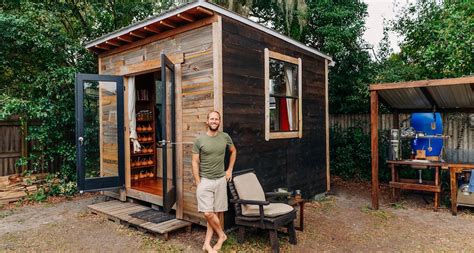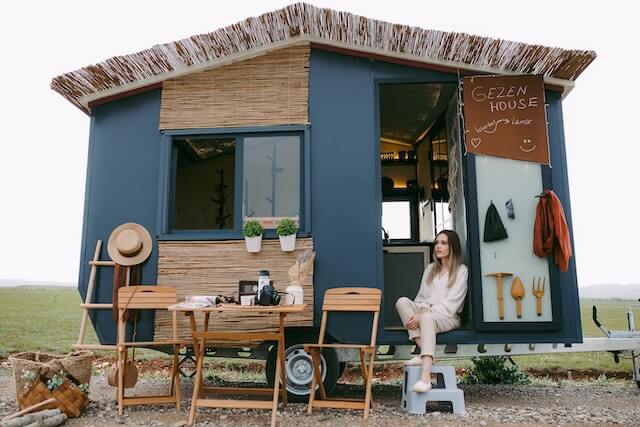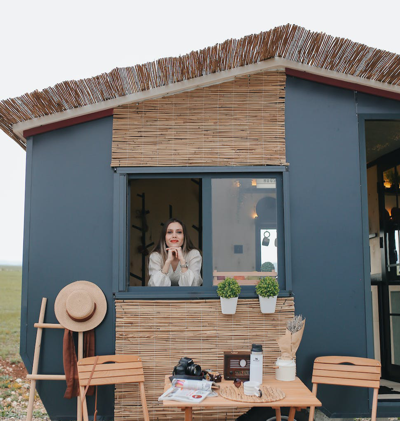Purchasing a Tiny House on Wheels, or THOW for short, is a dream come true for people on a budget that want to own a nice home, and like the idea of having the option to live in new places.
Living tiny involves some downsizing, but it can also give you a sense of freedom and enhanced quality of life as a smaller percentage of your income goes to paying off your mortgage and therefore you have more money to spend on other things.
The average size of a new single-family home in the U.S. is around 2,200 square feet; but the average tiny house is only 225 square feet. Living tiny is about making the optimal use of space and it is a lifestyle choice that is growing in popularity.
Compared to traditional houses, tiny houses are a promising housing options for budget friendly homeowners as the cost of materials and length of construction is drastically reduced. Do not get to excited yet as tiny house construction in 2022 is not very cheap and so a lot of people try and save money by building their own tiny house.
Tiny houses on wheels range from $25,000 to $150,000. Note that this price range is generally based on the size and length of the tiny house. The material used on the build can also significantly affect its price.
A DIY Tiny House is Your Cheapest Option
Building a tiny house is usually your cheapest option. However, you must be mentally, physically, and financially prepared to handle everything from a massive building list of supplies, learn skills for building, provide all labor, financing, and get your tiny house build certified by RVIA or another certification association. A DIY Tiny house builder can spend anywhere from $15,000 to $75,00 on materials alone, depending on the square footage and material preferences.
Pros – DIY Tiny House
DIY tiny homes are most beneficial for people on a real budget that have the free time to build their own home. Building your own home gives you a real feeling of satisfaction, and you will spend less as you’ll only need to pay for materials.
However, if you don’t have construction experience, you might need to learn a lot; as building a tiny house is the same as building a larger house, it is just much smaller, so takes less materials and time.
Building your own THOW gives you control over what goes into your house, the layout, design, and the whole look of the house. You won’t be worried about another builder not meeting your expectation. You can build your dream home in your timeline with the right tools and research to back up your plan.
If you are a novice builder but are still interesting in a DIY Tiny House, then we recommend buying a Tiny House Shell or Tiny House Kit. Both these are a great option, allowing you to save money, but not have to build the actual structure of your tiny house.
Cons – DIY Tiny House
With a DIY scheme comes a bigger responsibility of dealing with everything on your own. True enough, it is your best budget-friendly option, but the risks you must take are also much larger than paying extra for a professional builder; especially if you don’t have any building experience.
Tasks like electrical installation, roofing, and plumbing could be dangerous for non-experts. You might make mistakes and waste money if you just watched a few videos about these tasks and proceeded with the work without an experts’ guidance.
DIY can be a trial-and-error process. With this comes redoing your mistakes and purchasing more materials that would suit your build preference. You can expect increased expenses and more build time if you’re not an expert builder.
On average, finishing an average size tiny home takes about 180 hours for a professional, and up to 500 hours for a DIY novice.
Buying a Tiny House from a Professional Builder
If you don’t have the time, skills, and interest to DIY, then buying a prefabricated or pre-built tiny homes is your best option. Many tiny home builders around the country cater to your needs and offer some customization and shipping to your location.
Compared to building one, buying a tiny house from a builder can cost more, depending on your preference and the level of luxury you want for your tiny home design. You may opt for a more budget-friendly option of buying pre-owned tiny houses for as little as $30,000. However, these preowned houses may have some flaws as they have already been used for years.
Note that tiny houses on wheels do not normally qualify for a mortgage, so you’d either pay in cash or take out a personal loan, or if you get an RVIA certified tiny home then some RV lenders can offer you a loan for your tiny home.
Tiny House on Wheels Approximate Cost per Square Foot
The table below shows the 2022 cost range of a tiny house on wheels per square foot. Covid and Inflation have hit the housing market hard in the last year and so tiny house prices have gone up significantly; but then, so have the costs for building larger homes. where in the U.S, the average home price is $428,000.
| Size | Cost |
| 150 square feet on 18-foot trailer | $15,000 – $60,000 |
| 200 square feet on a 26-foot trailer | $30,000 – $85,000 |
| 275 square feet on a 30-foot trailer | $39,000 – $99,000 |
| 350 square feet on 34-foot gooseneck trailer | $65,000 – $120,000 |
Small Houses Cost More per Square Foot
Smaller houses like tiny house cost more per square foot compared to bigger ones because they have less area to divide by the overall cost and in a smaller space you still have a kitchen, bathroom, plus optional lofts, all in a much smaller footprint than a traditional house
It is also important to note that tiny house lofts are not included in the square footage. The road-legal height of tiny houses on wheels that fits under bridges is 13 ½ feet off the ground. Since lofts in tiny houses on wheels do not meet the minimum ceiling height requirement, they are not included in a tiny home’s square footage.
Other Factors Affecting the Increasing Cost of a Tiny House on Wheels
What Size THOW is right for you?
The size of the tiny house also adds to the total cost, considering that smaller houses use fewer materials and take shorter to build than larger ones. Also, note that tiny houses have specific height, width, and length requirements set by the Department of Transportation (DOT).
The height of a tiny house set by DOT must fit under bridges and overheads, especially for tiny houses on wheels. Bridges on major highways have a clearance of at least 13.5 feet. Your tiny house must be shorter to avoid any inconvenience while traveling on the road.
What length tiny house you want is also determine by the size of your trailer. Most states require your trailer to be less than 8.5 feet wide, or you’ll need to have a special wide load permit. This measurement covers the two widest points in your trailer, usually the wheel wells.
In most cases, the maximum length including tow vehicle would be 53 feet. Therefore the maximum length of your actual tiny houses is around 34 ft, as the best trucks to tow your THOW are 19 to 22 feet.
Materials Used and Labor Expenses
Whether you go for a DIY build or buy a prefab tiny house, materials, and supplies would probably still cost you a lot. You could spend as little as $10,000 all the way up to $110,000 or more; depending on the type of material (rough or high-end) and the layout you’ll follow. Note that if you want a fancier build, you will need to purchase more high-end materials that would cost you more.
Unplanned Parking and Other Expenses
Finding a place to put your tiny house can be difficult and time consuming. You may need to buy your own land or find a great location that can rent you a parking spot.
If you find an off-grid location then you’ll need to install a solar system, composting toilet or septic system, greywater harvesting systems, freshwater tanks and much more.
Added to these are the furniture and appliances you’ll purchase, as some of the things you used to have in your traditional home may not fit the tiny ones.
The Bottom Line
Tiny houses are not for everyone, but for those people that can not afford a traditional house or are interested in a more relaxed and care free lifestyle, then owning a tiny house on wheels may be the perfect choice for your next home.





Responses